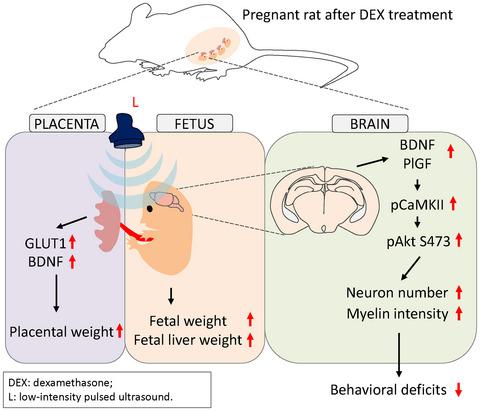当前位置:
X-MOL 学术
›
Brain Pathol.
›
论文详情
Our official English website, www.x-mol.net, welcomes your
feedback! (Note: you will need to create a separate account there.)
Antenatal low-intensity pulsed ultrasound reduces neurobehavioral deficits and brain injury following dexamethasone-induced intrauterine growth restriction
Brain Pathology ( IF 5.8 ) Pub Date : 2021-05-07 , DOI: 10.1111/bpa.12968 Tai-Ho Hung, Yu-Cheng Liu, Chun-Hu Wu, Chien-Cheng Chen, Hsien Chao, Feng-Yi Yang, Szu-Fu Chen
Brain Pathology ( IF 5.8 ) Pub Date : 2021-05-07 , DOI: 10.1111/bpa.12968 Tai-Ho Hung, Yu-Cheng Liu, Chun-Hu Wu, Chien-Cheng Chen, Hsien Chao, Feng-Yi Yang, Szu-Fu Chen

|
Intrauterine growth restriction (IUGR) is a leading cause of perinatal mortality and morbidity, and IUGR survivors are at increased risk of neurodevelopmental deficits. No effective interventions are currently available to improve the structure and function of the IUGR brain before birth. This study investigated the protective effects of low-intensity pulsed ultrasound (LIPUS) on postnatal neurodevelopmental outcomes and brain injury using a rat model of IUGR induced by maternal exposure to dexamethasone (DEX). Pregnant rats were treated with DEX (200 μg/kg, s.c.) and LIPUS daily from gestational day (GD) 14 to 19. Behavioral assessments were performed on the IUGR offspring to examine neurological function. Neuropathology, levels of neurotrophic factors, and CaMKII-Akt-related molecules were assessed in the IUGR brain, and expression of glucose and amino acid transporters and neurotrophic factors were examined in the placenta. Maternal LIPUS treatment increased fetal weight, fetal liver weight, and placental weight following IUGR. LIPUS treatment also increased neuronal number and myelin protein expression in the IUGR brain, and attenuated neurodevelopmental deficits at postnatal day (PND) 18. However, the number of oligodendrocytes or microglia was not affected. These changes were associated with the upregulation of brain-derived neurotrophic factor (BDNF) and placental growth factor (PlGF) protein expression, and enhancement of neuronal CaMKII and Akt activation in the IUGR brain at PND 1. Additionally, LIPUS treatment promoted glucose transporter (GLUT) 1 production and BDNF expression in the placenta, but had no effects on GLUT3 or amino acid transporter expression. Our findings suggest that antenatal LIPUS treatment may reduce IUGR-induced brain injury via enhancing cerebral BDNF/CaMKII/Akt signaling. These data provide new evidence that LIPUS stimulation could be considered for antenatal neuroprotective therapy in IUGR.
中文翻译:

产前低强度脉冲超声可减少地塞米松引起的宫内生长受限后的神经行为缺陷和脑损伤
宫内生长受限 (IUGR) 是围产期死亡率和发病率的主要原因,IUGR 幸存者神经发育缺陷的风险增加。目前还没有有效的干预措施来改善出生前 IUGR 大脑的结构和功能。本研究使用母体暴露于地塞米松 (DEX) 诱导的 IUGR 大鼠模型研究了低强度脉冲超声 (LIPUS) 对出生后神经发育结果和脑损伤的保护作用。从妊娠日 (GD) 14 到 19,每天用 DEX(200 μg/kg,sc)和 LIPUS 治疗怀孕的大鼠。对 IUGR 后代进行行为评估以检查神经功能。在 IUGR 大脑中评估了神经病理学、神经营养因子水平和 CaMKII-Akt 相关分子,检测了胎盘中葡萄糖和氨基酸转运蛋白和神经营养因子的表达。孕产妇 LIPUS 治疗增加了 IUGR 后的胎儿体重、胎儿肝脏重量和胎盘重量。LIPUS 治疗还增加了 IUGR 大脑中的神经元数量和髓鞘蛋白表达,并减轻了出生后第 18 天 (PND) 的神经发育缺陷。然而,少突胶质细胞或小胶质细胞的数量没有受到影响。这些变化与 PND 1 时脑源性神经营养因子 (BDNF) 和胎盘生长因子 (PlGF) 蛋白表达的上调,以及 IUGR 大脑中神经元 CaMKII 和 Akt 激活的增强有关。此外,LIPUS 治疗促进了葡萄糖转运蛋白 ( GLUT) 1 胎盘中的产生和 BDNF 表达,但对 GLUT3 或氨基酸转运蛋白的表达没有影响。我们的研究结果表明,产前 LIPUS 治疗可能通过增强脑 BDNF/CaMKII/Akt 信号传导来减少 IUGR 诱导的脑损伤。这些数据提供了新的证据,表明 LIPUS 刺激可以考虑用于 IUGR 的产前神经保护治疗。
更新日期:2021-05-07
中文翻译:

产前低强度脉冲超声可减少地塞米松引起的宫内生长受限后的神经行为缺陷和脑损伤
宫内生长受限 (IUGR) 是围产期死亡率和发病率的主要原因,IUGR 幸存者神经发育缺陷的风险增加。目前还没有有效的干预措施来改善出生前 IUGR 大脑的结构和功能。本研究使用母体暴露于地塞米松 (DEX) 诱导的 IUGR 大鼠模型研究了低强度脉冲超声 (LIPUS) 对出生后神经发育结果和脑损伤的保护作用。从妊娠日 (GD) 14 到 19,每天用 DEX(200 μg/kg,sc)和 LIPUS 治疗怀孕的大鼠。对 IUGR 后代进行行为评估以检查神经功能。在 IUGR 大脑中评估了神经病理学、神经营养因子水平和 CaMKII-Akt 相关分子,检测了胎盘中葡萄糖和氨基酸转运蛋白和神经营养因子的表达。孕产妇 LIPUS 治疗增加了 IUGR 后的胎儿体重、胎儿肝脏重量和胎盘重量。LIPUS 治疗还增加了 IUGR 大脑中的神经元数量和髓鞘蛋白表达,并减轻了出生后第 18 天 (PND) 的神经发育缺陷。然而,少突胶质细胞或小胶质细胞的数量没有受到影响。这些变化与 PND 1 时脑源性神经营养因子 (BDNF) 和胎盘生长因子 (PlGF) 蛋白表达的上调,以及 IUGR 大脑中神经元 CaMKII 和 Akt 激活的增强有关。此外,LIPUS 治疗促进了葡萄糖转运蛋白 ( GLUT) 1 胎盘中的产生和 BDNF 表达,但对 GLUT3 或氨基酸转运蛋白的表达没有影响。我们的研究结果表明,产前 LIPUS 治疗可能通过增强脑 BDNF/CaMKII/Akt 信号传导来减少 IUGR 诱导的脑损伤。这些数据提供了新的证据,表明 LIPUS 刺激可以考虑用于 IUGR 的产前神经保护治疗。











































 京公网安备 11010802027423号
京公网安备 11010802027423号